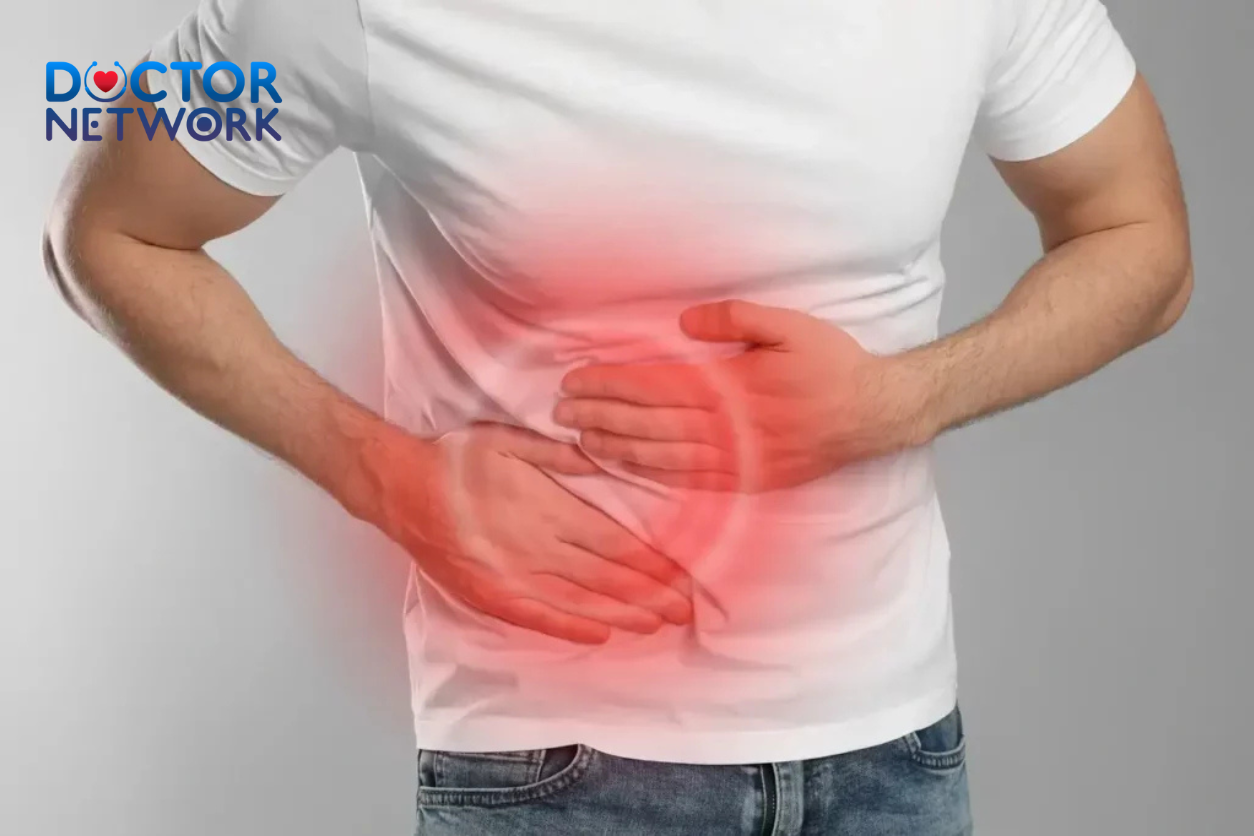Experiencing abdominal pain with diarrhea and nausea can be distressing and debilitating. This trio of symptoms often indicates an underlying gastrointestinal issue that requires attention. As a healthcare professional with over five decades of experience, I’ve seen countless patients grappling with these symptoms. In this comprehensive guide, we’ll explore the causes, symptoms, treatment options, and prevention strategies for this common yet complex condition. Understanding these aspects is crucial for managing your health effectively and knowing when to seek medical care.
Understanding the Symptoms
Abdominal Pain: The Cornerstone of Discomfort
Abdominal pain manifests in various forms, each potentially indicating different underlying issues. The pain can be sharp, resembling a knife-like sensation, or dull and aching. Some patients describe it as cramping, similar to menstrual cramps but often more intense.
Location plays a crucial role in diagnosis:
- Upper abdominal pain might suggest issues with the stomach or pancreas
- Lower abdominal pain could indicate problems in the intestines or reproductive organs
- Right-sided pain might point to appendicitis or gallbladder issues
- Left-sided pain could be related to diverticulitis or kidney problems

Left-sided pain could be related to diverticulitis or kidney problems
Severity ranges from mild discomfort to severe, debilitating pain that interferes with daily activities.
Diarrhea: The Urgent Companion
Diarrhea, characterized by loose or watery stools, often accompanies abdominal pain in gastrointestinal disorders. The frequency can vary:
- Occasional: A few times a day
- Frequent: Multiple times daily, disrupting normal activities
- Constant: Seemingly endless trips to the bathroom
The consistency of stool provides valuable diagnostic clues:
- Watery diarrhea often indicates viral gastroenteritis or food poisoning
- Loose stools might suggest irritable bowel syndrome (IBS) or dietary issues
- Bloody diarrhea is a red flag that requires immediate medical attention, potentially indicating inflammatory bowel disease (IBD) or severe infections
Nausea: The Queasy Culprit
Nausea, that unpleasant sensation of wanting to vomit, often accompanies abdominal pain and diarrhea. Its severity can range from mild queasiness to overwhelming sickness that leads to vomiting.
Associated Symptoms: The Supporting Cast
Several other symptoms often accompany this triad:
- Bloating: A feeling of fullness or swelling in the abdomen
- Gas: Excessive flatulence or belching
- Loss of appetite: Reduced desire to eat
- Fatigue: Feeling tired or weak
- Fever: Elevated body temperature, often indicating infection
- Chills: Feeling cold and shivery
- Weight loss: Unintended drop in body weight, particularly concerning if rapid or significant
Table 1: Symptom Severity Guide
| Symptom | Mild | Moderate | Severe |
|---|---|---|---|
| Abdominal Pain | Noticeable but doesn’t interfere with activities | Impacts daily activities | Debilitating, unable to perform normal tasks |
| Diarrhea | 3-4 loose stools per day | 5-7 watery stools per day | >7 watery stools per day, signs of dehydration |
| Nausea | Occasional queasiness | Persistent nausea, occasional vomiting | Constant nausea, frequent vomiting |
Common Causes of Abdominal Pain with Diarrhea and Nausea
Gastroenteritis: The Stomach Flu Culprit
Gastroenteritis, colloquially known as the “stomach flu,” is a common cause of this symptom triad. Despite its name, it’s not related to influenza. Gastroenteritis can be caused by:
- Viruses (e.g., norovirus, rotavirus)
- Bacteria (e.g., E. coli, Salmonella)
- Parasites (e.g., Giardia)
Symptoms typically last 1-3 days for viral cases and up to a week for bacterial infections. Treatment focuses on managing symptoms and preventing dehydration.
Food Poisoning: When Meals Turn Malicious
Food poisoning shares many symptoms with gastroenteritis but is specifically caused by consuming contaminated food or drinks. Common culprits include:
- Undercooked meat or seafood
- Unwashed fruits and vegetables
- Dairy products past their expiration date
Symptoms usually begin within hours of consuming the contaminated item and can last for 1-3 days. Prevention is key: practice safe food handling, cook foods thoroughly, and be cautious when dining out.
Irritable Bowel Syndrome (IBS): The Chronic Challenger
IBS is a functional gastrointestinal disorder characterized by recurrent abdominal pain and altered bowel habits. While its exact cause remains unknown, factors such as stress, certain foods, and hormonal changes can trigger symptoms.
Management of IBS involves:
- Dietary modifications (e.g., low FODMAP diet)
- Stress reduction techniques
- Regular exercise
- In some cases, medication prescribed by a healthcare provider

In some cases, medication prescribed by a healthcare provider
Inflammatory Bowel Disease (IBD): The Inflammatory Intruder
IBD, which includes Crohn’s disease and ulcerative colitis, involves chronic inflammation of the digestive tract. Symptoms can be severe and may include:
- Bloody diarrhea
- Severe abdominal pain
- Weight loss
- Fatigue
Diagnosis often requires endoscopy and imaging studies. Treatment typically involves anti-inflammatory medications, immunosuppressants, and in some cases, surgery.
Other Conditions: The Differential Diagnosis
Several other conditions can cause abdominal pain with diarrhea and nausea:
- Appendicitis: Inflammation of the appendix, often requiring surgery
- Diverticulitis: Inflammation of small pouches in the colon
- Gallstones: Hardened deposits of bile that can cause severe pain
- Pancreatitis: Inflammation of the pancreas
- Peptic Ulcer Disease: Sores in the lining of the stomach or small intestine
Table 2: Comparison of Common Causes
| Condition | Onset | Duration | Characteristic Features |
|---|---|---|---|
| Gastroenteritis | Sudden | 1-3 days (viral), up to 1 week (bacterial) | Often accompanied by fever |
| Food Poisoning | Rapid (within hours) | 1-3 days | Can affect multiple people who ate the same food |
| IBS | Gradual | Chronic, with flare-ups | Pain often relieved by bowel movement |
| IBD | Gradual | Chronic, with remissions and relapses | May include bloody stools, weight loss |
When to Seek Medical Attention
Red Flags: Warning Signs That Demand Action
While many cases of abdominal pain with diarrhea and nausea resolve on their own, certain symptoms warrant immediate medical attention:
- Severe, persistent abdominal pain
- Bloody diarrhea or black, tarry stools
- High fever (above 102°F or 39°C)
- Persistent vomiting that prevents keeping liquids down
- Signs of dehydration:
- Extreme thirst
- Dry mouth and skin
- Dark urine or decreased urination
- Dizziness or lightheadedness
- Unexplained weight loss
- Recent travel to an area with poor sanitation
When to See a Doctor: Erring on the Side of Caution
Even without red flags, medical evaluation is advisable if:
- Symptoms persist for more than a few days
- There’s no improvement with home remedies
- You have concerns about underlying health conditions
- Symptoms interfere significantly with daily activities
Remember, it’s always better to err on the side of caution when it comes to your health.
Home Remedies and Treatment Options
Home Remedies: First Line of Defense
For mild cases, several home remedies can provide relief:
- Rest: Allow your body time to heal
- Hydration: Drink clear fluids to prevent dehydration
- Water
- Clear broths
- Electrolyte solutions
- Bland diet (BRAT diet):
- Bananas
- Rice
- Applesauce
- Toast
- Over-the-counter medications:
- Antidiarrheal agents (e.g., loperamide)
- Anti-nausea medications (e.g., dimenhydrinate)
- Pain relievers (e.g., acetaminophen)
Medical Treatment: When Professional Intervention Is Necessary
In more severe cases or when home remedies aren’t effective, medical treatment may include:
- Antibiotics: For bacterial infections
- Anti-inflammatory medications: Particularly for IBD
- Prescription pain relievers
- IV fluids: For severe dehydration
- Surgery: In rare cases, such as appendicitis or severe IBD
Prevention and Lifestyle Modifications
Preventing Gastroenteritis and Food Poisoning: A Public Health Approach
- Practice proper hand hygiene:
- Wash hands thoroughly with soap and water, especially before eating and after using the bathroom
- Use alcohol-based hand sanitizers when soap and water aren’t available
- Ensure safe food handling:
- Cook foods to proper temperatures
- Avoid cross-contamination between raw and cooked foods
- Refrigerate perishables promptly
- Consider vaccinations:
- Rotavirus vaccine for infants
- Hepatitis A vaccine for high-risk individuals or travelers
Lifestyle Changes for IBS: Managing the Chronic Condition
- Dietary modifications:
- Identify and avoid trigger foods
- Consider a low FODMAP diet under medical supervision
- Stress management techniques:
- Mindfulness meditation
- Deep breathing exercises
- Regular physical activity
- Maintain a regular exercise routine:
- Aim for at least 150 minutes of moderate exercise per week
General Tips for Digestive Health: A Holistic Approach
- Maintain good hygiene: Regular handwashing and proper food handling
- Eat a balanced diet: Rich in fruits, vegetables, and whole grains
- Stay hydrated: Aim for 8 glasses of water per day
- Manage stress: Practice relaxation techniques and maintain work-life balance

Manage stress: Practice relaxation techniques and maintain work-life balance
FAQs: Addressing Common Concerns
Q1: How long does abdominal pain with diarrhea and nausea typically last?
A1: Duration varies depending on the cause. Viral gastroenteritis usually lasts 1-3 days, while bacterial infections may persist for up to a week. Chronic conditions like IBS can have recurring symptoms over months or years.
Q2: Is abdominal pain with diarrhea and nausea always serious?
A2: Not always. Many cases are due to mild, self-limiting conditions. However, persistent or severe symptoms warrant medical attention.
Q3: When should I see a doctor for abdominal pain with diarrhea and nausea?
A3: Seek medical care if symptoms persist beyond a few days, are severe, or accompanied by red flags like bloody stools, high fever, or signs of dehydration.
Q4: What can I eat when I have abdominal pain with diarrhea and nausea?
A4: Start with clear liquids and gradually introduce bland foods like bananas, rice, applesauce, and toast (BRAT diet). Avoid fatty, spicy, or sugary foods until symptoms improve.
Q5: What are some common misconceptions about abdominal pain with diarrhea and nausea?
A5: Common myths include:
- All cases require antibiotics (most viral cases don’t)
- Fasting is always beneficial (hydration and some nutrition are important)
- It’s always due to something you ate (many causes are unrelated to food)
Scientific researches
- “Epidemiology of Functional Gastrointestinal Disorders: A Global Perspective” by Enck et al., published in the World Journal of Gastroenterology in 2016. This study provides an overview of the global prevalence of functional gastrointestinal disorders.
- “Rome IV Functional Gastrointestinal Disorders and Motility Disorders” by Drossman, published in the Gastroenterology journal in 2016. This is an important study that updated the diagnostic criteria for functional gastrointestinal disorders.
- “Acute Diarrhea in Adults and Children: A Global Perspective” by Farthing et al., published in the Journal of Clinical Gastroenterology in 2013. This study addresses the causes, diagnosis, and treatment of acute diarrhea.
- “Pathophysiology, Evaluation, and Management of Chronic Watery Diarrhea” by Schiller et al., published in Gastroenterology in 2017. This review focuses on the pathogenesis and management of chronic diarrhea.
- “Nausea and Vomiting: State of the Science and New Perspectives for Gastroenterology” by Andrews and Sanger, published in Nature Reviews Gastroenterology & Hepatology in 2018. This is a comprehensive review of the mechanisms and management of nausea and vomiting.
In conclusion, abdominal pain with diarrhea and nausea is a common yet potentially serious combination of symptoms. By understanding the causes, recognizing warning signs, and knowing when to seek medical attention, you can manage these symptoms effectively. Remember, your health is paramount – when in doubt, consult a healthcare professional. Stay informed, practice prevention, and listen to your body to maintain optimal digestive health.
References:
https://www.medicalnewstoday.com/articles/vomiting-and-diarrhea-with-stomach-pain
https://www.vinmec.com/eng/article/what-causes-abdominal-pain-and-diarrhea-en
Kiểm Duyệt Nội Dung
More than 10 years of marketing communications experience in the medical and health field.
Successfully deployed marketing communication activities, content development and social networking channels for hospital partners, clinics, doctors and medical professionals across the country.
More than 6 years of experience in organizing and producing leading prestigious medical programs in Vietnam, in collaboration with Ho Chi Minh City Television (HTV). Typical programs include Nhật Ký Blouse Trắng, Bác Sĩ Nói Gì, Alo Bác Sĩ Nghe, Nhật Ký Hạnh Phúc, Vui Khỏe Cùng Con, Bác Sỹ Mẹ, v.v.
Comprehensive cooperation with hundreds of hospitals and clinics, thousands of doctors and medical experts to join hands in building a medical content and service platform on the Doctor Network application.


























